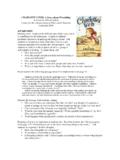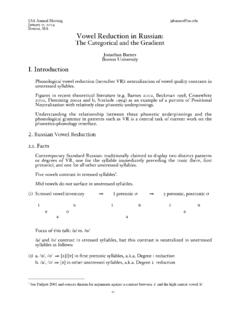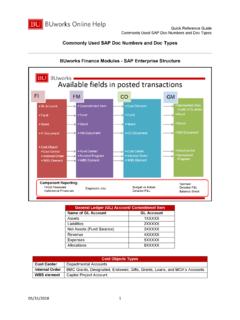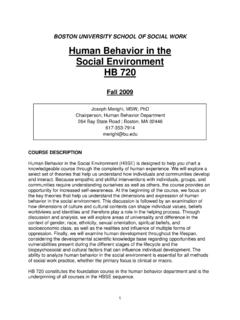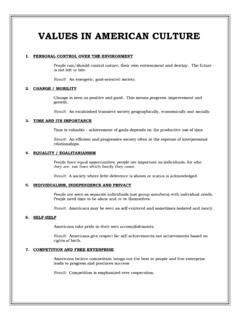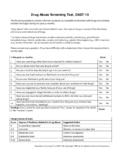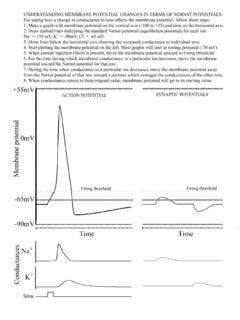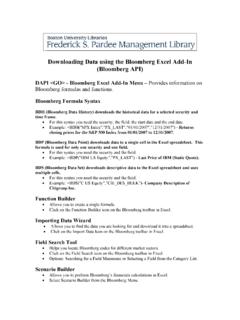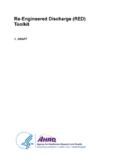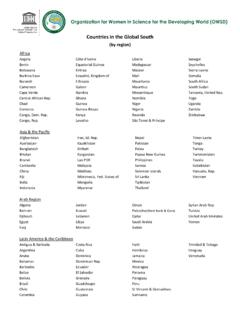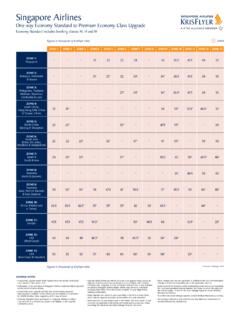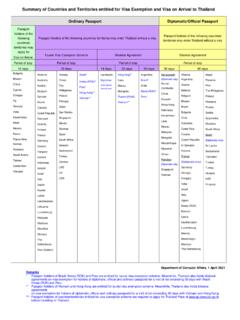Transcription of RCEP: Goods Market Access Implications for ASEAN
1 Global Development Policy CenterGEGI@GDPC enterPardee School of Global Studies/Boston UniversityGLOBAL ECONOMIC GOVERNANCE INITIATIVE WORKING PAPER 045 03/2021 RCEP: Goods Market Access Implications for ASEANRASHMI BANGA, KEVIN P. GALLAGHER AND PRERNA SHARMAABSTRACT:Free trade agreements (FTAs) are often signed by the developing countries in the hope of increasing their Market Access , improving their balance of trade (BOT) and reviving their economic growth by generating additional output and employment in their countries. How-ever, if FTAs worsen the BOT or net exports, they can adversely impact Gross Domestic Product (GDP) growth and employment in the country.
2 In this context, this paper under-takes a detailed disaggregated product-level impact analysis of tariff liberalisation under Regional Comprehensive Economic Partnership (RCEP) on BOT of Association of South East Asian Nations ( ASEAN ) countries. It uses World Integrated Trade Solutions (WITS)-SMART simulations incorporating the sensitive lists (SLs) and tariff rate quotas (TRQs) negotiated by countries in the RCEP. Such an analysis is not possible using any other meth-odology, especially the computable general equilibrium (CGE) models which use aggregate sector level data and are based on unrealistic assumptions.
3 The results of the simulations show that tariff liberalisation under RCEP will deteriorate the existing BOT of ASEAN vis- -vis RCEP countries by six percent per annum, while BOT will improve for some of the non- ASEAN countries in the RCEP. The maximum gains in terms of improved BOT will go to Japan, followed by New Zealand. Post RCEP, BOT will worsen for cambodia , Indonesia, Lao PDR, Malaysia, myanmar , Philippines, Singapore, thailand , and vietnam . The results show that imports of almost all ASEAN countries increase from China, except for Lao PDR and vietnam . However, China s imports increase mainly from Japan and Korea, Rep.
4 , while its Rashmi Banga is a Senior Economic Affairs Officer in the Unit on Economic Cooperation and Integration among Develop-ing Countries (ECIDC), United Nations Conference on Trade and Development (UNCTAD). She is former Head, Trade Com-petitiveness in Commonwealth Secretariat, where the Division provided policy support to more than 30 countries. She was a former Professor in Delhi Uni-versity. She has been recipient of two Gold Medals for her research on globalization and develop-ment from Global Development Network, World @GDPC enterPardee School of Global Studies/Boston University2 decline from all ASEAN countries.
5 China also experiences a worsening of its trade balance along with Korea, Rep. Exports to RCEP countries are estimated to fall for Cambo-dia, Malaysia, myanmar , Philippines, Singapore, and vietnam because of trade diversion in favour of more efficient exporters within the RCEP, while it will marginally improve for Indonesia, Lao PDR and thailand , although the increase in their exports will be less than the increase in their imports. ASEAN countries will also lose tariff revenues at a time when their industrial and trade growth have been adversely impacted due to the pandemic and domestic financial resources are needed for reviving their economies and repaying their debts.
6 Keywords: RCEP, SMART Simulations, Tariff Liberalisation Impact, Balance of Trade, Sensitive Lists and Tariff Rate Quotas, Tariff Revenue Loss1 IntroductionThe pandemic-hit global economy is facing multiple crises including health, economic, financial, and environmental. While developed countries are rolling out trillions of dollars worth economic recov-ery packages, developing countries lack the financial resources to boost their economies. Accord-ing to United Nations Conference on Trade and Development (UNCTAD) Trade and Development Report Update (2020)1, developing countries will not only be hit harder but will also take more time to recover.
7 For developing countries to recover faster and recover better with resilient growth, it is important for them to revisit their trade and industrial policies. International trade can be an important vehicle for delivering growth if it improves a country s balance of trade (BOT), gener-ates additional employment by boosting net exports, generates additional tariff revenues especially from imports of luxury items and provides important inputs and raw materials needed for indus-trial growth. To this end, trade agreements can be useful policy tools, but it is important to assess whether they are able to provide additional Market Access and the associated gains.
8 In this context, the paper estimates the additional Market Access that can be achieved by developing countries through the Regional Comprehensive Economic Partnership (RCEP). RCEP is an agree-ment negotiated initially between the ten members of the Association of South East Asian Nations ( ASEAN ): Brunei-Darussalam, cambodia , Indonesia, Laos People s Democratic Republic, Malaysia, myanmar , Philippines, Singapore, thailand , and vietnam plus the six countries with which ASEAN has free trade agreements (FTAs)- Australia, China, India, Japan, South Korea, and New Zealand.
9 However, India withdrew from the RCEP negotiations in November 2019 leaving 15 member coun-tries of RCEP to negotiate the agreement. RCEP was signed virtually between the 15 countries in November 2020 but has not yet been ratified by all countries. The text of RCEP has 20 chapters including trade in Goods , trade in services, investment, e-commerce, intellectual property, govern-ment procurement and competition. This paper focuses on the chapter on Goods and estimates the impact of RCEP on net exports and BOT of RCEP member countries, aiming at estimating the addi-tional Market Access which can be generated for ASEAN countries.
10 1 Kevin P. Gallagher is a Professor of Global Development Policy at Boston University s Pardee School of Global Stud-ies and Director of the Global Development Policy Center. Gal-lagher also serves on the United Nations Committee for Develop-ment Policy and co-chairs the T-20 Task Force on International Financial Architecture at the G Sharma is an Australia-based Consultant with United Nations Confer-ence on Trade and Development (UNCTAD). She has a Masters in Economics and previously worked as a Consultant with the United Nations Develop-ment Programme, Deloitte and PwC in the area of international trade and development.
